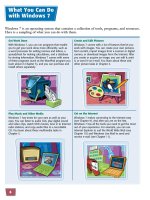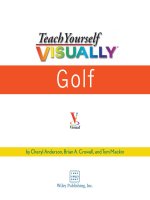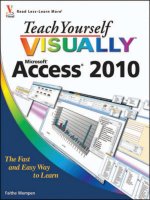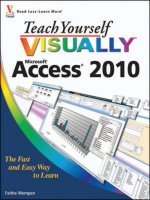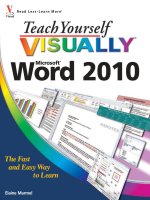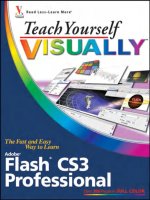teach yourself visually piano
Bạn đang xem bản rút gọn của tài liệu. Xem và tải ngay bản đầy đủ của tài liệu tại đây (18.07 MB, 306 trang )
01_749907 ffirs.qxp
3/21/06
5:35 PM
Page iii
Piano
by Mary Sue Taylor and Tere Stouffer
01_749907 ffirs.qxp
3/21/06
5:35 PM
Page i
Piano
01_749907 ffirs.qxp
3/21/06
5:35 PM
Page ii
Hear Audio Tracks from This Book at wiley.com!
In case you need a little help in understanding how a particular piece is supposed to sound,
we’ve included audio tracks from this book on our Web site. You can access those files via
this link: www.wiley.com/go/tyvpiano. Here’s a list of the tracks that you’ll find there:
Chapter 5
Just for You
A Minuet
Bill Bailey
Chapter 6
Jazz Piece #1
Jazz Piece #2
Jazz Piece #3
Chapter 7
Playing a Piece in Parallel Motion
Are You Upbeat?
Contrary Motion Exercise in C
Chapter 8
Saving Time
Piece of Coda
Play This Tacet
Louie’s Blues
Playing from the Head
Hot Staccato
Let Me Call You Sweetheart
Play Your Triplets
French Dance
Evening Song
Chapter 9
Moonlight Sonata
Fugue
Frere Jacques
April Showers
Alexander’s Ragtime Band
God Bless America
Chapter 10
My Ragtime Piece
Playing a Chromatic Piece
Jazz Lines for the Right Hand
Walking Bass
Playing the Blues
Swinging Right-Hand Patterns
12-Bar Blues
Boogie Woogie Piece
Country Song in F
Playing Rock ‘n’ Roll
New Age Sounds
01_749907 ffirs.qxp
3/21/06
5:35 PM
Page iii
Piano
by Mary Sue Taylor and Tere Stouffer
01_749907 ffirs.qxp
3/21/06
5:35 PM
Page iv
Teach Yourself VISUALLY™ Piano
Copyright © 2006 by Wiley Publishing, Inc., Hoboken, New Jersey. All rights reserved.
Published by Wiley Publishing, Inc., Hoboken, New Jersey
No part of this publication may be reproduced, stored in a retrieval system or transmitted in any form or by any means, electronic,
mechanical, photocopying, recording, scanning or otherwise, except as permitted under Sections 107 or 108 of the 1976 United States
Copyright Act, without either the prior written permission of the Publisher, or authorization through payment of the appropriate percopy fee to the Copyright Clearance Center, 222 Rosewood Drive, Danvers, MA 01923, (978) 750-8400, fax (978) 646-8600, or on
the web at www.copyright.com. Requests to the Publisher for permission should be addressed to the Legal Department, Wiley
Publishing, Inc., 10475 Crosspoint Blvd., Indianapolis, IN 46256, (317) 572-3447, fax (317) 572-4355, or online at
/>Wiley, the Wiley Publishing logo, Teach Yourself VISUALLY, and related trademarks are trademarks or registered trademarks of John
Wiley & Sons, Inc. and/or its affiliates. All other trademarks are the property of their respective owners. Wiley Publishing, Inc. is not
associated with any product or vendor mentioned in this book.
The publisher and the author make no representations or warranties with respect to the accuracy or completeness of the contents of this
work and specifically disclaim all warranties, including without limitation warranties of fitness for a particular purpose. No warranty may
be created or extended by sales or promotional materials. The advice and strategies contained herein may not be suitable for every situation. This work is sold with the understanding that the publisher is not engaged in rendering legal, accounting, or other professional services. If professional assistance is required, the services of a competent professional person should be sought. Neither the publisher nor
the author shall be liable for damages arising here from. The fact that an organization or Website is referred to in this work as a citation
and/or a potential source of further information does not mean that the author or the publisher endorses the information the organization or Website may provide or recommendations it may make. Further, readers should be aware that Internet Websites listed in this
work may have changed or disappeared between when this work was written and when it is read.
For general information on our other products and services or to obtain technical support please contact our Customer Care Department
within the U.S. at (800) 762-2974, outside the U.S. at (317) 572-3993 or fax (317) 572-4002.
Wiley also publishes its books in a variety of electronic formats. Some content that appears in print may not be available in electronic
books. For more information about Wiley products, please visit our web site at www.wiley.com.
Library of Congress Control Number: 2005939198
ISBN-13: 978-0-471-74990-5
ISBN-10: 0-471-74990-7
Printed in the United States of America
10
9
8
7
6
5
4
3
2
1
Book production by Wiley Publishing, Inc. Composition Services
01_749907 ffirs.qxp
3/21/06
5:35 PM
Page v
Praise for the Teach Yourself VISUALLY Series
I just had to let you and your company know how great I think your books are. I just purchased my third Visual book (my first two are dog-eared now!) and, once again, your product has surpassed my expectations. The expertise, thought, and effort that go into each
book are obvious, and I sincerely appreciate your efforts. Keep up the wonderful work!
—Tracey Moore (Memphis, TN)
I have several books from the Visual series and have always found them to be valuable
resources.
—Stephen P. Miller (Ballston Spa, NY)
Thank you for the wonderful books you produce. It wasn’t until I was an adult that I discovered how I learn—visually. Although a few publishers out there claim to present the
material visually, nothing compares to Visual books. I love the simple layout. Everything is
easy to follow. And I understand the material! You really know the way I think and learn.
Thanks so much!
—Stacey Han (Avondale, AZ)
Like a lot of other people, I understand things best when I see them visually. Your books
really make learning easy and life more fun.
—John T. Frey (Cadillac, MI)
I am an avid fan of your Visual books. If I need to learn anything, I just buy one of your
books and learn the topic in no time. Wonders! I have even trained my friends to give me
Visual books as gifts.
—Illona Bergstrom (Aventura, FL)
I write to extend my thanks and appreciation for your books. They are clear, easy to follow, and straight to the point. Keep up the good work! I bought several of your books and
they are just right! No regrets! I will always buy your books because they are the best.
—Seward Kollie (Dakar, Senegal)
01_749907 ffirs.qxp
3/21/06
5:35 PM
Page vi
Credits
Acquisitions Editor
Pam Mourouzis
Project Editor
Suzanne Snyder
Technical Editor
Martha Thieme
Editorial Manager
Christina Stambaugh
Publisher
Cindy Kitchel
Vice President and Executive Publisher
Kathy Nebenhaus
Interior Design
Kathie Rickard
Elizabeth Brooks
Cover Design
José Almaguer
Interior Photography
Matt Bowen
Dedication
To my daughter, Valerie Rehm. She is a photographer in Seattle. She has a passion for nature
and travels to many beautiful locations capturing the beauty of the earth. She has been a
great encouragement to me in my writing of this book.
—Mary Sue Taylor
Special Thanks...
Thanks to Meridian Music in Carmel, Indiana, especially President Craig Gigax, for
providing the location for many of the photos in this book.
01_749907 ffirs.qxp
3/21/06
5:35 PM
Page vii
About the Authors
Mary Sue Taylor has taught beginning piano, jazz, improvisation,
chord study, and other related topics to a diverse array of students
since 1956. She has also filled her share of musical requests, having played piano in the Atlanta area since 1954. Over the years,
she has dusted the keys of nearly every piano in the Atlanta area,
from formal society clubs to dim, smoke-filled jazz bars to the
hottest house parties. She lives in Roswell, Georgia, with her
husband, Jimmy.
Tere Stouffer is a freelance author and editor who has now broken
into the double digits—this is her tenth book. She lives in
Knoxville, Tennessee, with her chocolate Lab, Maxine, who kept
her feet warm on many a late winter night spent working on this
manuscript.
Acknowledgments
Writing any book takes an amazing team of people, and this book was no different. We give
a heart-felt thanks for acquisitions editor Pam Mourouzis, who championed this book and
got us started. Project editor Suzanne Snyder then took over the project and couldn’t have
been a better fit for us: With a musicology degree, she was a tremendous help when we
struggled to explain challenging topics. She and editorial manager Christina Stambaugh
patiently organized and edited not only the text but also hundreds of photos and pieces of
music. Our photographer, Matt Bowen, was responsible for the beautiful photos throughout
the book.
02_749907 ftoc.qxp
3/21/06
5:44 PM
Page viii
Table of Contents
1
chapter
The Piano
The History of the Piano . . . . . . . . . . . . . . . . . . . . . . . . . . . . . . . . . . . . . . . . . . . . . . . . .4
The Sounding Board . . . . . . . . . . . . . . . . . . . . . . . . . . . . . . . . . . . . . . . . . . . . . . . . . . . .5
Pedals . . . . . . . . . . . . . . . . . . . . . . . . . . . . . . . . . . . . . . . . . . . . . . . . . . . . . . . . . . . . . . . .6
The Keyboard . . . . . . . . . . . . . . . . . . . . . . . . . . . . . . . . . . . . . . . . . . . . . . . . . . . . . . . . . .8
Playing Position, Posture, and Hand Position . . . . . . . . . . . . . . . . . . . . . . . . . . . . . . .14
2
chapter
Reading Music and Playing Notes
The Staff . . . . . . . . . . . . . . . . . . . . . . . . . . . . . . . . . . . . . . . . . . . . . . . . . . . . . . . . . . . . .18
Notes on the Staff . . . . . . . . . . . . . . . . . . . . . . . . . . . . . . . . . . . . . . . . . . . . . . . . . . . . .20
Sharps, Flats, and Naturals . . . . . . . . . . . . . . . . . . . . . . . . . . . . . . . . . . . . . . . . . . . . . .24
Key Signature and Time Signature . . . . . . . . . . . . . . . . . . . . . . . . . . . . . . . . . . . . . . . .26
Ledger Lines and Octave Signs . . . . . . . . . . . . . . . . . . . . . . . . . . . . . . . . . . . . . . . . . . .29
Some Exercises . . . . . . . . . . . . . . . . . . . . . . . . . . . . . . . . . . . . . . . . . . . . . . . . . . . . . . . .31
How to Practice Your Fingering . . . . . . . . . . . . . . . . . . . . . . . . . . . . . . . . . . . . . . . . . . .34
02_749907 ftoc.qxp
3/21/06
3
chapter
5:44 PM
Page ix
Steps and Intervals
Steps on the Piano Keyboard . . . . . . . . . . . . . . . . . . . . . . . . . . . . . . . . . . . . . . . . . . . .46
Keyboard Intervals . . . . . . . . . . . . . . . . . . . . . . . . . . . . . . . . . . . . . . . . . . . . . . . . . . . . .49
Exercises in Steps and Intervals . . . . . . . . . . . . . . . . . . . . . . . . . . . . . . . . . . . . . . . . . .51
Arpeggios . . . . . . . . . . . . . . . . . . . . . . . . . . . . . . . . . . . . . . . . . . . . . . . . . . . . . . . . . . . .58
Answers to Intervals Test . . . . . . . . . . . . . . . . . . . . . . . . . . . . . . . . . . . . . . . . . . . . . . . .61
4
chapter
Dynamics and Tempo
Dynamics . . . . . . . . . . . . . . . . . . . . . . . . . . . . . . . . . . . . . . . . . . . . . . . . . . . . . . . . . . . .64
Ties . . . . . . . . . . . . . . . . . . . . . . . . . . . . . . . . . . . . . . . . . . . . . . . . . . . . . . . . . . . . . . . . .67
Syncopation . . . . . . . . . . . . . . . . . . . . . . . . . . . . . . . . . . . . . . . . . . . . . . . . . . . . . . . . . .68
Phrases . . . . . . . . . . . . . . . . . . . . . . . . . . . . . . . . . . . . . . . . . . . . . . . . . . . . . . . . . . . . . .69
Tempo . . . . . . . . . . . . . . . . . . . . . . . . . . . . . . . . . . . . . . . . . . . . . . . . . . . . . . . . . . . . . . .70
02_749907 ftoc.qxp
3/21/06
5
chapter
5:44 PM
Page x
Warming Up
Right-Hand Five-Finger Warm Ups with Numbers . . . . . . . . . . . . . . . . . . . . . . . . . . .78
Left-Hand Five-Finger Warm Ups with Numbers . . . . . . . . . . . . . . . . . . . . . . . . . . . . .79
Right-Hand Five-Finger Warm Ups with Note Names . . . . . . . . . . . . . . . . . . . . . . . . .81
Left-Hand Five-Finger Warm Ups with Note Names . . . . . . . . . . . . . . . . . . . . . . . . . .82
Playing a Solo with Your Right Hand . . . . . . . . . . . . . . . . . . . . . . . . . . . . . . . . . . . . . .84
Playing Both Hands Together . . . . . . . . . . . . . . . . . . . . . . . . . . . . . . . . . . . . . . . . . . . .85
Playing without Finger Numbers or Note Names . . . . . . . . . . . . . . . . . . . . . . . . . . . .88
6
chapter
Chords
C Chord . . . . . . . . . . . . . . . . . . . . . . . . . . . . . . . . . . . . . . . . . . . . . . . . . . . . . . . . . . . . .92
F Chord . . . . . . . . . . . . . . . . . . . . . . . . . . . . . . . . . . . . . . . . . . . . . . . . . . . . . . . . . . . . . .96
G Chord . . . . . . . . . . . . . . . . . . . . . . . . . . . . . . . . . . . . . . . . . . . . . . . . . . . . . . . . . . . . .98
Solid and Broken Chords . . . . . . . . . . . . . . . . . . . . . . . . . . . . . . . . . . . . . . . . . . . . . .100
Crossing Fingers Over and Under . . . . . . . . . . . . . . . . . . . . . . . . . . . . . . . . . . . . . . . .102
Exercises . . . . . . . . . . . . . . . . . . . . . . . . . . . . . . . . . . . . . . . . . . . . . . . . . . . . . . . . . . . .107
Inversions . . . . . . . . . . . . . . . . . . . . . . . . . . . . . . . . . . . . . . . . . . . . . . . . . . . . . . . . . . .113
Lead Sheets . . . . . . . . . . . . . . . . . . . . . . . . . . . . . . . . . . . . . . . . . . . . . . . . . . . . . . . . .122
Three Jazz Pieces to Practice Chords . . . . . . . . . . . . . . . . . . . . . . . . . . . . . . . . . . . . .132
02_749907 ftoc.qxp
3/21/06
7
chapter
5:44 PM
Page xi
Meter, Harmony, and Movement
Playing in Waltz Time . . . . . . . . . . . . . . . . . . . . . . . . . . . . . . . . . . . . . . . . . . . . . . . . .140
Sight Reading . . . . . . . . . . . . . . . . . . . . . . . . . . . . . . . . . . . . . . . . . . . . . . . . . . . . . . . .142
Playing Four-Part Harmony . . . . . . . . . . . . . . . . . . . . . . . . . . . . . . . . . . . . . . . . . . . . .144
Parallel Motion . . . . . . . . . . . . . . . . . . . . . . . . . . . . . . . . . . . . . . . . . . . . . . . . . . . . . . .146
Upbeats . . . . . . . . . . . . . . . . . . . . . . . . . . . . . . . . . . . . . . . . . . . . . . . . . . . . . . . . . . . . .151
Contrary Motion . . . . . . . . . . . . . . . . . . . . . . . . . . . . . . . . . . . . . . . . . . . . . . . . . . . . . .152
8
chapter
Advanced Musical Terms
Staccato and Legato . . . . . . . . . . . . . . . . . . . . . . . . . . . . . . . . . . . . . . . . . . . . . . . . . . .160
Repeat Signs . . . . . . . . . . . . . . . . . . . . . . . . . . . . . . . . . . . . . . . . . . . . . . . . . . . . . . . . .164
How Fast and How Loud? . . . . . . . . . . . . . . . . . . . . . . . . . . . . . . . . . . . . . . . . . . . . . .168
Triplets . . . . . . . . . . . . . . . . . . . . . . . . . . . . . . . . . . . . . . . . . . . . . . . . . . . . . . . . . . . . . .172
Additional Exercises . . . . . . . . . . . . . . . . . . . . . . . . . . . . . . . . . . . . . . . . . . . . . . . . . . .174
02_749907 ftoc.qxp
3/21/06
9
chapter
5:44 PM
Page xii
Advanced Chords
Major-Minor Keys: Memorizing Key Signatures . . . . . . . . . . . . . . . . . . . . . . . . . . . .182
Major-Minor Triads: Building Thirds . . . . . . . . . . . . . . . . . . . . . . . . . . . . . . . . . . . . . .192
Suspended Fourth Chord . . . . . . . . . . . . . . . . . . . . . . . . . . . . . . . . . . . . . . . . . . . . . .195
Flat-Five Chord . . . . . . . . . . . . . . . . . . . . . . . . . . . . . . . . . . . . . . . . . . . . . . . . . . . . . . .196
Sixth Chord . . . . . . . . . . . . . . . . . . . . . . . . . . . . . . . . . . . . . . . . . . . . . . . . . . . . . . . . . .198
Seventh Chord . . . . . . . . . . . . . . . . . . . . . . . . . . . . . . . . . . . . . . . . . . . . . . . . . . . . . . .199
Chord Dictionary . . . . . . . . . . . . . . . . . . . . . . . . . . . . . . . . . . . . . . . . . . . . . . . . . . . . .202
Playing Three Old Favorites . . . . . . . . . . . . . . . . . . . . . . . . . . . . . . . . . . . . . . . . . . . . .210
10
chapter
Musical Styles
Ragtime . . . . . . . . . . . . . . . . . . . . . . . . . . . . . . . . . . . . . . . . . . . . . . . . . . . . . . . . . . . . .218
Jazz . . . . . . . . . . . . . . . . . . . . . . . . . . . . . . . . . . . . . . . . . . . . . . . . . . . . . . . . . . . . . . . .220
The Blues . . . . . . . . . . . . . . . . . . . . . . . . . . . . . . . . . . . . . . . . . . . . . . . . . . . . . . . . . . .224
Boogie Woogie . . . . . . . . . . . . . . . . . . . . . . . . . . . . . . . . . . . . . . . . . . . . . . . . . . . . . . .228
Country . . . . . . . . . . . . . . . . . . . . . . . . . . . . . . . . . . . . . . . . . . . . . . . . . . . . . . . . . . . . .230
Rock ’n’ Roll . . . . . . . . . . . . . . . . . . . . . . . . . . . . . . . . . . . . . . . . . . . . . . . . . . . . . . . . .232
New Age . . . . . . . . . . . . . . . . . . . . . . . . . . . . . . . . . . . . . . . . . . . . . . . . . . . . . . . . . . . .234
Improvising a Melody with Chords . . . . . . . . . . . . . . . . . . . . . . . . . . . . . . . . . . . . . .236
Making Up a Solo . . . . . . . . . . . . . . . . . . . . . . . . . . . . . . . . . . . . . . . . . . . . . . . . . . . .238
02_749907 ftoc.qxp
3/21/06
5:44 PM
Page 1
Additional Piano Pieces . . . . . . . . . . . . .244
Famous Composers, Pianists,
and Compositions . . . . . . . . . . . . . . . .270
Glossary . . . . . . . . . . . . . . . . . . . . . . . . . .278
Index . . . . . . . . . . . . . . . . . . . . . . . . . . . .287
03_749907 ch01.qxp
3/21/06
5:30 PM
chapter
Page 2
1
The Piano
To activate sound on a piano, you press a key, which releases a small
hammer that strikes a string. The string then vibrates with sound, which
is called a note. To reduce this vibration and soften the sound, you
press on a pedal.
03_749907 ch01.qxp
3/21/06
5:30 PM
Page 3
The History of the Piano . . . . . . . . . . . . . . . . . . . . . . . . . . . . . . . . . . .4
The Sounding Board . . . . . . . . . . . . . . . . . . . . . . . . . . . . . . . . . . . . . .5
Pedals . . . . . . . . . . . . . . . . . . . . . . . . . . . . . . . . . . . . . . . . . . . . . . . . . .6
The Keyboard . . . . . . . . . . . . . . . . . . . . . . . . . . . . . . . . . . . . . . . . . . . .8
Playing Position, Posture, and Hand Position . . . . . . . . . . . . . . . .14
03_749907 ch01.qxp
3/21/06
5:31 PM
Page 4
The History
of the Piano
The piano was invented in the early
eighteenth century by Bartolomeo
Cristofori of Florence, Italy.
Cristofori’s job was to design and
maintain the keyboard instruments
used in the court of Prince Ferdinand
de’ Medici. John Brent of Philadelphia
built the first piano in the United
States in 1774.
Cristofori was a maker of harpsichords and clavichords (the two predecessors of the piano), so it is reasonable that his
instrument would be similar to these instruments, but—instead—capable of softness and loudness. Harpsichords are
neither soft nor loud; nor can they produce much of a sustained tone. This is because the strings of the harpsichord are
plucked with quills or plectra. Clavichords are more like pianos, in that the strings are struck with metal tangents. The
tone produced by a clavichord, however, is soft. Cristofori’s invention used hammers to hit the strings. Depending on
the pianist’s touch at the keyboard, a key could be pressed lightly (producing a soft tone), or struck with enough force
that it produced a loud tone. And, unlike both the harpsichord and the clavichord, a tone could be sustained on the
piano, depending on the pianist’s desire. Cristofori’s original name for the piano was gravicembalo col piano e forte,
which means “harpsichord with soft and loud.”
Cristofori’s invention soon became known as the fortepiano, which distinguished the eighteenth-century instrument
from its predecessors and today’s piano, the full name of which is the pianoforte. Cristofori’s early fortepiano had one
relatively thin string per note and was much softer than today’s pianos. By Mozart’s time, it had two strings per note
and the hammers were covered in leather. A German organ builder named Gottfried Silbermann began making fortepianos in the 1730s. He is responsible for adding a forerunner of today’s damper pedal, which you will be learning about
later in this chapter.
The eighteenth-century fortepiano keyboard often didn’t look the way the piano’s keyboard looks today. Many fortepianos had keyboards that resembled the keyboard of the harpsichord of the time, in which the white keys were black
and the black keys were white.
In the nineteenth century, the piano underwent many changes. The frame changed from wood to iron, enabling strings
to become thicker and strung with more tension without breaking. (String breakage had been a problem: Beethoven
was constantly hitting keys with such force that strings broke.) More strings were added and more octaves. You’ll learn
about octaves later in this book. The hammers were covered with felt to achieve better tone quality from the new steel
strings. At this point, let’s leave the subject of the history of the piano and look at how today’s piano is constructed.
4
03_749907 ch01.qxp
3/21/06
5:31 PM
Page 5
The Sounding
Board
The Piano
1
chapter
The piano’s sounding board, an internal part of the piano that you normally can’t see unless you have a baby
grand or grand piano with the lid up,
has four parts: strings of different
sizes, pins, hammers, and dampers.
What’s Inside
The hammers strike the strings, and the vibration of the strings may
be dampened (that is, reduced) by the dampers. The pedals, discussed in the following section, allow the player to alter the string
vibration.
The thickest, longest strings produce the deepest and most
resonant sounds, while thinner, shorter strings produce higher, less
resonant sounds. The lowest range of the piano uses one string per
tone; the middle range uses two strings for more resonance; and
the highest range uses three strings for even more resonance. The
very highest range needs all the help it can get to resonate, so there
are no dampers there. The pins are the little metal objects that are
used to tune the strings.
5
03_749907 ch01.qxp
3/21/06
5:31 PM
Page 6
Pedals
There are three pedals on the piano: the damper pedal, the soft pedal, and the sostenuto pedal. The
pedals are found at the bottom of the piano, below the keyboard, and you push them with your feet.
Types of Pedals
DAMPER PEDAL
The right-most pedal is called the
damper pedal or loud pedal and is
used more than the other two pedals.
It’s called a damper, because it holds
the dampers up, preventing them
from dampening the strings, thus letting the strings ring until you release
(lift your foot off) the pedal. In this
way, the damper pedal enables you
to sustain notes as you play.
SOFT PEDAL
The left-most pedal is the soft pedal,
and on the grand piano it softens the
sound of notes by shifting the keyboard slightly to the right so that the
hammers hit one less string in the
middle and high ranges (see the
“What’s Inside” section, earlier). For
this reason, the soft pedal is sometimes also called the una corda,
which is Italian for “one string.” On
upright pianos, the soft pedal works
differently, but it still softens the
sound of the notes.
Soft pedal
Damper pedal
Sostenuto pedal
SOSTENUTO PEDAL
The middle pedal is the sostenuto (sus-tah-new-toe) pedal and is not used as much as the other two. Sostenuto is
Italian for “sustained,” which makes sense because—like the damper pedal—this pedal holds the dampers above a specific note or notes you want to sustain. You can, meanwhile, use the other pedals at the same time and it won’t affect
the notes being sustained by the sostenuto pedal.
Note that many less expensive upright pianos do not have a sostenuto pedal, but instead have a practice pedal that
muffles the sound so that you can play without disturbing your neighbors if you live in an apartment or if it is late at
night. Virtually all grand pianos have a sostenuto pedal, as do some of the more expensive uprights.
6



